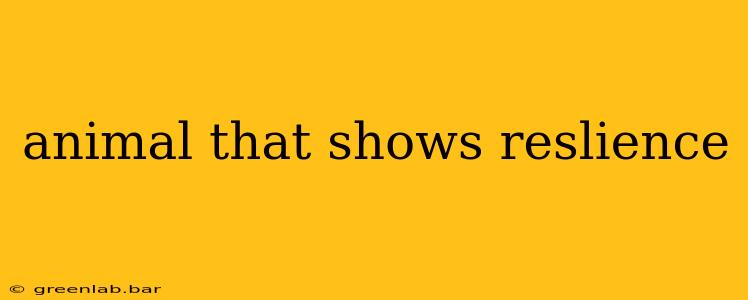Resilience—the ability to bounce back from adversity—is a quality we often admire in humans. But the animal kingdom is brimming with examples of incredible resilience, showcasing survival strategies that are both awe-inspiring and humbling. This post explores several animals known for their remarkable ability to overcome challenges, highlighting their adaptations and inspiring stories.
The Cockroach: A Master of Survival
The cockroach, often reviled as a pest, is a testament to the power of resilience. These insects demonstrate exceptional adaptability, thriving in diverse environments, from sewers to high-rise buildings. Their resilience stems from several key factors:
- Rapid Reproduction: Cockroaches reproduce rapidly, ensuring population continuation even after significant losses.
- Hardiness: Their exoskeletons provide protection, and they can withstand high levels of radiation.
- Adaptability to Food Sources: Cockroaches are omnivorous, consuming a wide range of materials, enhancing their survival chances in resource-scarce environments.
The Tardigrade (Water Bear): Indestructible Micro-Animal
Microscopic yet mighty, the tardigrade, or water bear, is perhaps the ultimate example of resilience in the animal kingdom. These tiny creatures can withstand extreme conditions that would obliterate most other life forms:
- Cryptobiosis: This state of suspended animation allows tardigrades to survive extreme dehydration, radiation, and even the vacuum of space. Essentially, they can "shut down" their bodies until conditions improve.
- Extremophile Capabilities: They can tolerate temperatures ranging from near absolute zero to well above boiling, showcasing an unparalleled ability to endure harsh environments.
The Honeybee: A Collaborative Force of Nature
While individual honeybees are fragile, the resilience of a bee colony is truly remarkable. They face numerous threats, including pesticides, habitat loss, and disease, yet many colonies continue to thrive through:
- Social Structure: The highly organized social structure allows for efficient resource management and cooperative defense mechanisms.
- Adaptability to Climate Change: Some bee populations are adapting to changing climates by shifting their foraging patterns and adjusting their brood cycles.
- Collective Intelligence: The hive's collective intelligence facilitates decision-making and problem-solving, ensuring the survival of the colony as a whole.
The Red Fox: Adaptable Predator
The red fox, a widespread and successful predator, exhibits remarkable resilience through:
- Behavioral Flexibility: Red foxes demonstrate an impressive ability to adapt their hunting strategies and diet depending on available prey.
- Urban Adaptation: They've successfully adapted to living alongside humans in urban environments, exhibiting a remarkable capacity to exploit human-altered landscapes.
- Intelligence and Cunning: Their intelligence and cunning allow them to avoid predators and overcome environmental challenges.
Conclusion: Lessons from Resilient Animals
Studying the resilience of animals offers valuable insights into survival strategies and adaptability. Their remarkable abilities to overcome adversity provide inspiration and highlight the importance of understanding and protecting biodiversity. By studying these examples, we can learn more about effective coping mechanisms and potentially improve our own resilience in the face of environmental change and other challenges. Further research into these and other resilient species will undoubtedly uncover even more fascinating insights into the secrets of survival.

